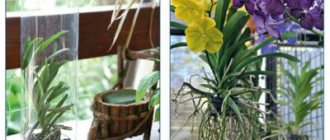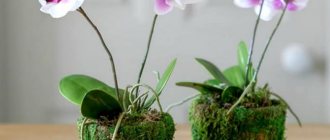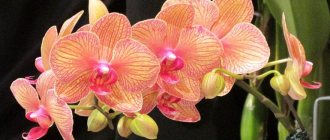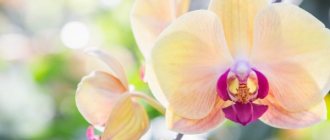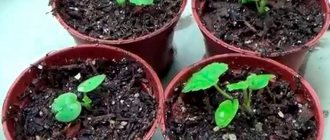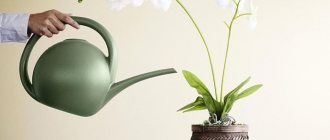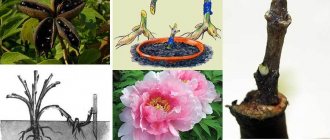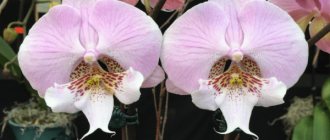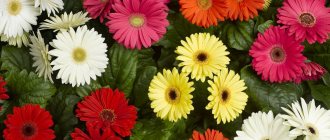An orchid in glass is original, unusual and beautiful. A flower placed in such a pot can be given as a gift to a friend, or can decorate your own room. Due to the tightly sealed lid, the water does not evaporate, which means there will be no need to constantly add liquid.
Often a plant in a flask is found in Asian countries, where it is very fashionable to purchase orchids in this form. However, you should understand that using a narrow transparent container (in which the beauty is sold) will not work, because, despite good care, the flower will not last long in this state.
Typically, a plant in a glass flask is a seedling, not an adult flower, so those people who want to try themselves as gardeners can pay attention to these options.
Contents in flasks
The difference lies not only in their beautiful blooms, but also in their breeding methods. While many flowers grow on the ground, orchids grow from tree bark, clinging to it. They obtain useful components and moisture with the help of aerial roots. Moisture comes from the air or fog, and useful components from their residues that accumulate in the tree bark. But this process occurs in the humid tropics, where the habitat for orchids is very suitable. It is impossible to create such an atmosphere in indoor conditions. There is more than one method for growing an orchid:
- growing in water - hydroponics;
- orchid without substrate and liquid;
- breeding in soil.
If the roots of the plant are constantly in liquid, they will begin to rot. Therefore, they should not be completely submerged, but rather be above the liquid. It is not necessary to switch to keeping it in a flask right away, especially for the flower itself:
- First you need to pull it out of the ground, clean the roots, put it in water for a couple of days, and then dry it the next day. You do not need to drain the liquid completely, but so that one centimeter of the roots are still immersed in it.
- After a week, the orchid can be left in the water for several days, but one day should be allowed to dry.
- Afterwards, leave the phalaenopsis in the water for the entire time, changing it and observing the condition of the roots. If they change color to silver, it means the flower needs to be watered.
At this time, the growth of new aerial roots will be noticeable, and green shoots will begin to appear on the old ones.
Please note! With this method, growing may be difficult due to rot on the roots. To cope with it, you need to take the flower out of the water for a day and treat the roots with a fungicide. If algae appears on them, then you should not get rid of them, as this helps air exchange
A small part of the roots dies off if the habitat has changed to aquatic, and instead of them appear those that are adapted for the plant to stay in water
If algae appears on them, then you should not get rid of them, as this helps air exchange. A small part of the roots dies off if the habitat has changed to aquatic, and instead of them, those adapted for the plant to stay in water appear.
To prevent the appearance of fungus, you need to use semi-hydroculture - an unusual substrate that does not provide the flower with any nutritional components, but keeps it in a standing position. The flower receives all its nutrition through fertilizers, which are diluted in water. They are easily digestible, and therefore do not waste a lot of energy, directing it to development.
First steps in care
Watering the plants in summer is carried out once a week or 10 days. It all depends on the ambient temperature or the size of the pot in which the plant grows. In winter, water once every 2 weeks.
Watering is best done using the immersion method. To do this, select a container in size so that the container with the plant is immersed almost completely over the surface of the pot. This is necessary so that the bark gets wet evenly over the entire height of the pot.
The dive time is half an hour. The water should be soft and warm. Many books advise using rain or melt water. But it can only be used if the grower lives in a rural area.
Otherwise, all the smog in the city will be in rainwater and this will cause irreparable harm to the flower. After watering, you need to make sure that the water completely drains from the pot, and only after that it is placed in the pan.
IMPORTANT! The water should not be cold so as not to chill the roots of the plant.
Permanent residence
First of all, you need to familiarize yourself with the basic requirements for cultivating a flower and adhere to them. If you do not follow them, this may lead to the death of the plant.
Primary requirements:
- Lighting – you should choose the right habitat for the orchid in the apartment. The illumination should be high, but all sunlight should be diffused, since direct rays can burn the vegetative part of the flower in 30 minutes. This is especially dangerous in the summer. Daylight should last up to 15 hours. If there is not enough light for some reason, then it will be necessary to organize additional lighting;
- Temperature – the temperature regime for problem-free orchids is from 18 to 25 degrees Celsius. At low temperatures, the flower may die from cold air and humidity. At higher temperatures, the flower falls into stagnation, this is when the roots stop absorbing moisture. Therefore, if possible, then at temperatures above 30 degrees Celsius, flowers are placed near the air conditioner, or at least simply placed on the floor, where the temperature is lower;
- Humidity – at home, air humidity is 80% and therefore this is optimal when growing flowers.
It is important to observe these factors when growing a plant
Transfer
The transplant must be done for the simple reason that it is not known what the root system looks like. It’s no secret that while in a store, a flower can be constantly flooded and its root mass can actively rot.
Therefore, while the flower finishes blooming, rot may well spread from the roots to the small trunk of the plant. And this can already lead to the death of the entire flower.
IMPORTANT! After purchasing, admire the flowering for a couple of days and begin replanting the flower.
Adaptation to a new place
In order for the plant to adapt to a new place, it is quarantined separately from other plants. 10 days will give you the opportunity to evaluate how healthy the purchased plant is. If the substrate is wet, the flower should not be watered.
Because even after the bark has dried, you must remember that there is a peat cup under the trunk that holds moisture for a long time. This is good when transporting a flower, but has a detrimental effect when growing a plant at home.
After adaptation, experienced gardeners recommend replanting the plant.
Top dressing
The first feeding is carried out a month after transplantation or after the end of flowering. At the first signs of new leaf growth, they begin to fertilize the orchid. In this case, only those fertilizers that are intended for orchids are used.
All the rest can not improve the condition of the flower, but can lead to its death. Because they contain many times more minerals than is necessary for the growth of an orchid.
IMPORTANT! Fertilizing is not carried out when the plant is in the dormant or flowering stage.
Behind the blooming orchid
It is not recommended to feed a flowering plant, as this will shorten its flowering period. It will only need the correct watering regime with warm, settled, soft water.
Possible problems
Beginning gardeners may encounter a number of difficulties when growing an unusual plant. Ignoring the problems that have arisen can lead to his death. Experts highlight a list of the most common problems when growing orchids and ways to solve them.
- Rotting of foliage - improper watering. If the trunk is damaged by rot, the plant cannot be saved.
- Wilting is damage to the root system by dangerous insects.
- The appearance of mold deposits is due to low light levels.
- Mechanical damage to the root system is a violation of transportation rules.
- Root rotting is a violation of the watering regime.
- Musty smell – non-compliance with ventilation rules.
- Salt deposits and algae - failure to comply with sanitary standards and irregular washing of the vessel.
- The soft structure of the foliage means the presence of infection in the substrate or drainage.
Particular attention should be paid to the most common diseases of this plant:
- spotting;
- fusarium;
- bacterial rot;
- viral diseases.
Among the dangerous insects, the following species should be highlighted:
- thrips;
- scale insects;
- mealybug;
- spider mite
For information on how to properly transplant an orchid into a glass flask, see below.
Tips and secrets of professionals
Since the orchid is difficult to care for, the advice of professional flower growers will be very helpful in solving emerging problems with the flower.
What to do if the root system is very weak
In the case of a weakened, damaged root system, the orchid is removed from the glass container, the defective roots are removed and for some time, to form a powerful, viable system, it is placed in a mini-greenhouse. To do this, a five-liter plastic bottle is cut transversely on three sides, a layer of wet substrate (bark, moss, expanded clay) is placed on the bottom, into which a plant with pre-cut peduncles is placed. The bottle is tightly closed, securing the structure with tape. From time to time the container is opened to ventilate and moisten the substrate. After time, the roots should get stronger and recover.
Ventilation and aeration of the plant
As mentioned above, ventilation of the root system is ensured by a sufficient volume of the flowerpot and periodic removal of the plant from the vessel for forced ventilation and drying of the roots. As for the flower as a whole, it is not recommended to expose it to sharp drafts, especially in winter, as this can lead to frostbite of the leaf plates (manifested in the form of dark spots). When ventilating the room, the plants must be moved to more comfortable conditions at this time.
Did you know? Cut orchid flowers or its peduncle “live” in a vase with water longer than all other flowers.
Disinfection of containers
This manipulation will minimize the development of rot, algae, and deposits of mineral salts. To do this, the plant is removed, and the vase itself is treated with a weakly concentrated solution of potassium permanganate or special fungicidal preparations, after which the dishes are washed with running water.
Of course, the orchid does not belong to the “typical” indoor flower, which traditionally grows in the ground. However, by following the recommendations of professional flower growers and adhering to agrotechnical techniques for keeping phalaenopsis and other types of orchids, you can decorate the surrounding space with exotic flowers.
Care
Let's consider caring for an orchid in glass at home. Caring for a plant in a glass vase is not very different from traditional caring for an orchid in a substrate, but it does have a number of nuances that you need to know about and take into account. First of all, this concerns:
- The vase itself;
- Her material;
- Forms;
- And the place of residence of the plant.
Watering
Watering a plant in a glass vase is no different from watering an orchid growing in an ordinary pot or flowerpot. The procedure is simple: you need to carefully pour water into the vase in such an amount that the roots are completely immersed and moistened. Water should be:
- Soft;
- Seated;
- With minimal content of mineral salts.
This is important, first of all, for the delicate roots of the orchid, and will also help preserve the decorative appearance of the glass. After all, mineral salts form a deposit after the water evaporates, which is clearly visible and does not look very attractive.
Advice! It is ideal to use rain or melt water, of course, only if the precipitation collection process was carried out in an ecologically clean region.
After 30-45 minutes, the water must be carefully drained
Do this with extreme caution because:
- Wet glass is very slippery;
- The vase may accidentally slip out of your hands;
- Break and injure you or others with fragments.
Make sure that there is no water left in the container after draining. The average watering frequency is:
- 2-3 times a week in warm weather;
- And once a week, if it’s cloudy outside.
It is always necessary to monitor the plant and take into account its current needs. On hot summer days, watering can be daily. It is better to choose the time for the procedure in the first half of the day, so that by the evening the plant has time to dry.
Feeding and pest control
Under natural conditions, fertilizing occurs naturally, when rain washes off the humic substances formed on the surface of the tree bark directly onto the roots of the epiphyte. Therefore, when grown indoors, these plants require competent and dosed feeding.
It is better to feed the orchid after flowering.
The most important thing to remember is that it is better to fertilize frequently with a weak solution of fertilizers than to fertilize infrequently with a strong one. This is also explained by the same features of feeding orchids in nature. After all, rain in the tropics does not wash away a very rich layer of substances, but it does so quite often.
In practice, this means that during the period of active growing season and growth of green mass, the orchid should be fed with liquid fertilizers once every 1-2 weeks at ¼ of the concentration indicated on the package.
Advice! Before the procedure, it is necessary to moisten the roots of the plant with water to minimize the risk of burns from the fertilizer solution. Foliar feeding, alternating with root feeding, has proven effective.
Pest treatments are carried out with diluted insecticides from a sprayer. Use a fine mist sprayer. It is necessary to process all parts of the plant (on all sides), except for flowers.
How to monitor the health of the roots?
The best disease prevention is to maintain plant hygiene at an optimal level. In this case it is necessary:
- Select a container size sufficient for the plant’s roots to fit freely inside;
- There was also the possibility of ventilation and free access of air inside.
Unacceptable:
- Hypothermia of roots;
- As well as debris and dirt inside the vase.
Remove dead leaves and roots from the plant promptly.
Ventilation
It is enough to periodically remove the plant from the container and leave it in free space for some time. You can do this:
- While swimming;
- Or when you need to wash a vase from accumulated dirt.
Attention! Sometimes orchid roots can stick to the walls of the vase, so care must be taken when removing the plant from the container.
Home care
All orchids, and Vandas are no exception, need good care, and if you decide to grow them at home, you will have to work hard to create these very conditions; they are incredibly demanding to keep and require a lot of attention. Vanda is often called the queen of orchids and her care is also royal.
These plants do not have a dormant period; they belong to evergreen orchids and can bloom almost all year round, more abundantly in the spring and summer. After flowering, the flower stalks need to be cut off. The temperature for Vanda should not be below twenty degrees (otherwise the plant loses its ability to resist diseases), and they feel best at twenty-five degrees.
There should be a lot of lighting for this type of orchid (but not under the scorching sun). If there is little light, the orchid will not bloom, and if there is a large deficit of sun, then Wanda will get sick. The duration of daylight for this orchid should be twelve hours (which is quite difficult to organize at home).
The humidity in the room where Vandas grow should be at least seventy percent and no more than ninety percent, which can be maintained at home only with the help of a humidifier. Spraying orchids in dry, cool air or at night is harmful to these plants and leads to the development of diseases. Changes in humidity are very dangerous for this plant, so the orchid must be protected from this phenomenon.
Another important condition for Vanda’s well-being will be sufficient air circulation, since the plant must be well ventilated, otherwise this will lead to rotting of the neck. At home, you can install a fan next to the plants for this.
The Vanda orchid needs additional feeding, which is using complex fertilizers (once a week and only in the morning), and washing (every few months with a lemon solution in the ratio of one teaspoon of freshly squeezed juice per one liter of water at a temperature slightly above room temperature ). You can increase fertilizing during flowering, but if the plant is sick, then on the contrary, fertilizing will only cause harm.
Watering the Vanda orchid should be plentiful, but careful. You need to water in the morning, and in the summer take a morning bath (place the plant in water for a third of an hour until the root system acquires a green tint). In autumn, water only when there is sunlight, otherwise the plant is watered every few days. In winter, you can water the plant only after the substrate has completely dried.
The health of a flower depends on proper care for it.
These orchids are replanted as they grow from the pot (approximately every three years). They don’t take large pots for Wanda, because in such spaces she slows down her growth. It grows in a specialized mixture, which is bought in flower shops (you can prepare it yourself, but it’s unlikely to be cheaper or of better quality). There is no need to trim the Vada (only if the stems have become too tall, you can cut off the top part and replant it in the substrate).
As a container for the Vanda orchid, you can use hanging baskets, pots with side holes or a vase. If you grow Vanda in a vase, then there should be no water in it; in this case, the plant must sometimes be taken out and dipped in water with fertilizer, dried and moved back. Although you can simply pour water into a vase and wait until air bubbles stop coming out, indicating the need for liquid. When the orchid “gets drunk,” the water is poured out of the vase. If the orchid is constantly in water, then it begins to rot, and if the container is closed, then the plant will die altogether. It is ideal when the vase has a wide base and the green shoots are located outside it. Hanging baskets are convenient because they give “freedom” to roots, which can reach a length of more than a meter.
Treatment
The vase must be washed periodically, as the following accumulates on the inner walls:
- Algae layer;
- And mineral deposits.
The disinfection procedure or prevention can be carried out using:
- A weak solution of potassium permanganate (of course, the plant should be removed);
- Or fungicides.
This orchid is susceptible to diseases such as:
- Spotting, which may be caused by excessive moisture in the substrate or air. In diseased plants, wart-like spots form on the underside of the leaf. It is often caused by fungal diseases that actively develop in warm and damp rooms. In this case, rounded black spots appear on the upper side of the leaves. Orchids fight spotting by creating a favorable environment for the flower. When planting plants, the substrate is disinfected. Water Wanda with water in which special antifungal drugs such as Trichodermin or Fitosporin are dissolved.
- Rot caused by waterlogging of the substrate. Most often, the disease progresses on cool days or when using containers that are unsuitable for the orchid. With this disease, rotting of roots and stems is observed. The tissues of the flower soften and turn black. Very quickly the plant turns yellow and dies. To combat this disease, the substrate is disinfected before planting orchids. The plant is watered in accordance with the requirements of agricultural technology. The drug "Maxim" is added to the water.
| Manifestation | Cause | Elimination method |
| Round black markings appear on the leaves along their entire length. | Fungal infection. | Treat infected areas with a fungicide. Reduce the frequency of watering to once a week, maintain a constant temperature of 23... 25 °C. Cover with a cloth, avoid bright light. |
| The horse system rots, becomes covered with a black coating and dies. The stem with leaves dries up. | Bacterial rot. | Remove infected areas and cover cut areas with phytosporin. Replace the soil and disinfect the container. Antibiotics (tetracycline) are also effective in a ratio of 1 gram per liter. |
| Black dots appear on the outside of the leaf, and the stem may become covered with brown lines. | Viral infection. | It is impossible to completely cure. You should get rid of the infected plant to avoid spreading the infection. |
| Small green insects appear throughout the orchid. The stems and leaves wither and the plant dies. | Aphid. | Increase the air humidity, treat the flower with a soap solution or tincture of lemon zest. Special intestinal preparations (Intavir, Actofit) are best suited for pest control. |
| Small beige pests on leaves, flower stalks, buds and stems. White coating and waxy deposits. Wanda is fading. | Mealybug. | Remove growths and affected parts of the plant. Treat the bulb with an alcohol solution and remove the parasites. Aktara, Mospilan, Aktellik, Calypso are excellent for wrestling. |
| Small voids appear on the leaves and stem. Yellow spots appear, shoots die. | Shield. | A solution of soap and alcohol, fern tincture and chemicals such as Permethrin, Bi 58, Phosfamide, Methylmercaptophos will help get rid of the pest. |
Growing orchids in glass pots (vases)
Although Vanda looks very elegant in this form, such content is very conditional for it. The reason is that only the roots of the plant should be in the flask behind the transparent glass, while the beard should be free to be in the space.
Tall vases are not suitable for these purposes - the plant should not be completely contained in the container, otherwise it suffers from stuffiness, and there is also an increased risk of rotting.
When grown in this way, the orchid suffers from a lack of air.
Microclimate
Keeping them in vases has its advantages. A humid microclimate is formed in the glass flask, which is very beneficial for the roots of the plant, since in nature it grows in a very humid climate. However, you should be careful because the glass cools quickly and can chill the roots. Cold and moisture can cause mold and rot.
As already mentioned, tall, elongated glass pots are not suitable for vanda, but wide, glass-shaped ones will do. The size should be sufficient for the roots to fit freely inside. The plant itself should be on the surface from the base of the rosette, flush with the edges of the vase, and not buried inside. You can secure the vanda in this position with wire.
Attention! You can grow vanda in a plastic container. A large bottle with the top cut off will do.
The use of plastic eliminates the disadvantages of glass - fragility and low thermal conductivity.
Vanda orchid care at home. Planting and watering
The frequency of watering Vanda depends on the method of growing it. You can contain it:
- in a lattice basket, with very large pine bark;
- with an open root system;
- in a glass vase or transparent container, without soil.
In the first case, it is very easy to destroy the orchid, since keeping Vanda in the soil is contrary to its nature: the roots of the plant require free breathing, and not constant moisture. In addition, constant moisture at the base of the orchid stem leads to its rotting and rapid death of the plant. With this method of planting, watering is carried out once a week by soaking the basket with roots for 30 minutes.
Keeping Vanda with an open root system has its pros and cons. The advantage is that the roots breathe freely and the trunk has time to dry out quickly. The disadvantage of this type of cultivation: long roots break very easily, dry out and die. With this maintenance, watering is carried out every day with the help of a shower, simulating natural growing conditions.
The third method is more convenient and gentle on the root system than the first two:
- it is convenient to water by soaking the roots in a container;
- do this not every day, but 2-3 times a week;
- the root system is not injured;
- good ventilation of the roots and lower part of the trunk.
Possible problems and difficulties
Growing orchids in water and regular soil is not always successful. In rare cases, problems may arise:
- The edges begin to wrinkle. The reason is high air temperature. During the day and night, the difference in changing temperature should not exceed 8C.
- Dryness and rotting of the root system. The reason is excessive watering, a pot that is too narrow, squeezing the roots, heavy watering after a long absence of water.
- No flowering. Treatment is heat stress. The difference between the temperature at night and during the day should be 12-14C.
Constantly keeping orchids in water is accompanied by the formation of a disease, the cause of which is pathogenic microorganisms, for example:
- fungi;
- bacteria.
Please note! To prevent problems, you need to properly care for your beauties. The ideal microclimate for fungus is a damp and secluded place, for example, a glass flowerpot in which there is no ventilation. Preventive measures include periodic ventilation of the container
Epiphytes absolutely need air, as it can prevent:
Preventive measures include periodic ventilation of the container. Epiphytes absolutely need air, as it can prevent:
- moisture stagnation;
- mold formation with bacteria.
Phalaenopsis in water needs:
- sufficient lighting;
- maintaining the desired temperature;
- proper watering.
Requirements and fit
Often, even experienced gardeners are interested in whether it is possible to plant an orchid in a glass pot, but the answer will be positive if:
- an orchid without soil will be an initially healthy plant;
- drainage will be properly formed;
- the substrate will be carefully selected;
- ensure strict control over watering.
Important!
Glass vases for orchids are not considered the best way, since if the container is narrow and cylindrical, then the foliage, gradually growing, will begin to bend and break on the edges.
A flask that is too high can cause a slow outflow of moisture and insufficient air, which will soon lead to fungus and rotting. Therefore, a vase for an orchid should have a leg, a wide bottom and not too narrow a top, and such a height that the roots are inside the vessel, but the leaves are outside.
An orchid must also be planted in compliance with the rules presented by experts in the field of botany:
- A glass pot for orchids must be disinfected with boiling water or sterilized by steam.
- Cover the bottom of the container with a layer of expanded clay chips, also pre-treated with disinfectant compounds.
- Glass pots should contain sphagnum moss.
- The rest of the space will be filled with phalaenopsis in a glass vase and a substrate that you can prepare yourself or purchase in stores. However, first, the contents of the pot with soil, but without the flower, need to be filled with warm water and left for half an hour to saturate it with moisture.
- Next, drain the water.
- Plant the plant in a layer of bark, and cover its surface with moss, previously soaked in water. Use it to lay out the area near the root collar.
How to care for an orchid in a flask?
Keeping an orchid in a vase has its advantages and disadvantages. A humid microclimate is formed and maintained behind the glass of the flask, which in turn is very useful for the root system of the epiphyte, since in nature they grow precisely in such conditions.
A significant drawback is the rapid cooling of the glass, which can cool the roots. And cold and moisture, as you know, are very harmful to orchid roots and can provoke the appearance of mold and rot.
In addition to the low thermal conductivity of glass, there is its fragility and high rate of contamination - with limescale, colonies of algae and fungi.
Advice! The disadvantages of glass are offset by another material – plastic. Even a plastic bottle with the top cut off may work.
You need to know about all these features of materials and shapes before placing the plant in such a container. If this does not stop the grower and a similar experiment is planned, it is also necessary to know about proper care in specific conditions.
Watering
The watering procedure is no different from what a gardener would do with a plant in a pot and flowerpot. It is necessary to carefully pour water into the flask so that all the roots are immersed. After 30-45 minutes, the water must also be carefully drained. Use rain, melt or filtered water with a minimum amount of dissolved mineral salts.
Watering is done in the usual way.
Attention! Be careful when draining water. The flask can become very slippery, you can drop it and accidentally injure yourself or others with shards of broken glass. After draining the water, you need to make sure that it does not remain in the vase
Watering is carried out as needed, depending on the condition and requirements of the plant. On average, this is 2-3 times a week in warm weather and 1 time in cloudy weather. On especially hot days, the frequency of watering can be daily. Watering is carried out in the morning so that the plant has time to dry out by night.
After draining the water, you need to make sure that it does not remain in the vase. Watering is carried out as needed, depending on the condition and requirements of the plant. On average, this is 2-3 times a week in warm weather and 1 time in cloudy weather. On especially hot days, the frequency of watering can be daily. Watering is carried out in the morning so that the plant has time to dry out by night.
Ventilation
For epiphytes, the presence of fresh air is extremely important. It is necessary to ventilate the plant periodically
The size of the container should be sufficient so that the orchid roots fit freely inside, can be ventilated, and air can easily get inside.
Disinfection of the flask
Over time, the glass of the container becomes covered from the inside with a layer of algae, fungi or a coating of salts. For this reason, the flask must be constantly washed and kept clean.
Disinfection can be carried out with a weak solution of potassium permanganate. During the procedure, remove the plant from the container.
Sometimes the orchid's roots get stuck to the sides of the vase, so be careful when removing it.
Feeding
Epiphytic orchids in nature feed on humic substances that collect in the cavities of tree bark or between stones. In cultivation, these plants, like no other, need proper feeding.
During the period of active growing season and growth of green mass, feed the orchid with liquid fertilizers at ¼ of the concentration indicated on the package. Before the procedure, it is necessary to moisten the roots of the plant with clean water - this measure is necessary in order to exclude the possibility of burning the delicate root system with the fertilizer solution. Such fertilizing can be alternated with foliar fertilizing “by leaf”.
Important! Feeding during the dormant period is sharply reduced or not carried out at all, depending on the type of particular orchid.
Disease Prevention
The best prevention is to keep the plant in proper conditions and maintain its hygiene. Care must be taken to ensure that the orchid receives a sufficient amount of light, especially in winter, when the length of daylight hours is sharply reduced. Hypothermia of the root system, dirt and debris inside the flask are also unacceptable. Remove dead roots and leaves of the plant in a timely manner.
Fungicide treatment
It is carried out for preventive purposes with systemic fungicides according to the instructions.
Due to improper watering, orchids may rot roots or leaves.
If the plant is nevertheless affected by bacteria or fungi, treatments are carried out in medicinal dosages.
Conditions for growing Vanda orchids
The Vanda orchid is light- and heat-loving; the most suitable place for its placement would be windows facing east and west.
Air temperature
During the spring-summer period, maintain the air temperature at 22-25 ° C (the plant can tolerate temperature increases up to +28 ° C). To stimulate flowering at night, lower the air temperature by about 10 °C. In winter, dry maintenance with an air temperature of 14-16 ° C will be required. With strict adherence to the rules of care (watering, air humidification, ventilation), the Vanda orchid grows and develops well. When ventilating, do not allow a draft; in the summer season you can move it to fresh air (on the balcony, in the garden, in the gazebo).
Lighting
The plant is demanding in terms of lighting: all year round, the duration of daylight hours should be 12 hours a day. Lighting must be diffused; direct sunlight will cause burns on the leaf blades. In the autumn-winter period, additional artificial lighting will be required. Use regular fluorescent lamps.
The level of illumination is indicated by the size and shade of the leaves. They should be a normal green color and almost the same size. If the shade of the leaf blades is dark green, there is not enough lighting; if it is pale green, yellowish, the lighting is intense. If the last pair of leaves grows longer than the penultimate one, the lighting level needs to be increased, and when it’s the other way around (the penultimate pair is longer), the lighting level should be reduced.
Basic principles of care
The main operations for caring for an orchid in a vase are watering, fertilizing, and preventing diseases. Labor costs for changing soil and replanting are reduced.
Flasks must be washed regularly
In order for the composition to have a decorative appearance, the flask must be washed to remove algae and salt deposits about once a month. Plants in hydroculture are removed once a year, the roots are inspected, and the salted layer of expanded clay (diatomaceous earth) is replaced.
Watering
Much attention is paid to the quality of water: ordinary water from the tap is clogged with metal salts; orchidists recommend using rainwater or purified by osmosis with the addition of up to 10% tap water. At home, you can filter water through peat, which removes excess calcium and reduces excess PH
At home, you can filter water through peat, which removes excess calcium and reduces excess pH.
Hydroculture irrigation technique:
- In expanded clay: sprayed from above, then watered with water and fertilizer.
- In perlite, diatomaceous earth, green mix: spray generously, then carefully pour over the inner wall of the vase.
Technique for watering orchids on a block:
- Remove the block from the greenhouse once every 2 weeks;
- immerse for 10-15 minutes in warm water, during the growth period - with fertilizer;
- attach in place.
- if the flowerpot is open, spray the orchid daily.
in winter
Phalaenopsis and vanda growing in expanded clay can be dried until the roots appear silvery. The roots are inspected for rotting.
For orchids resting for the season, the water in the vase is maintained at a level of up to 1 cm - it does not contain fertilizers, it is added in a thin stream along the inner wall of the pot.
Feeding
Fertilizers for orchids are added to irrigation water according to the instructions, without exceeding the dosage. Generally accepted norm:
- during the growth period - 1 ml per 1 liter of water;
- during the rest period - 0.5 ml per 1 liter.
When in doubt, it is better to pour the product in a lower concentration than indicated on the package.
- moderate temperature 20-25°C, at night not lower than 18°C;
- diffused light;
- timely removal of rotten roots;
- if necessary, spraying against pests, treating with fungicide.
What should you avoid?
Beginning gardeners often make a number of mistakes when growing an orchid, which lead to its death. To prevent this, experienced gardeners recommend:
- avoid overflow;
- When spraying, keep a distance of 20 cm from the plant;
- water only with warm, softened water;
- When immersing, use new water for each plant.
The approach to watering and its frequency also depend on the plant variety, so before purchasing it, you need to study all the recommendations for caring for a particular species.
Also on our website you can read separately about the nuances of watering orchids after transplantation and during flowering and learn about the secrets of watering indoor and outdoor flowers.
In pots made from natural materials
Raising exotic pets in containers made from natural and other materials is not excluded. Particularly popular are baskets made from:
- Trees;
- Bamboo;
- And even made of steel;
- Steel mesh;
- Or plastic.
Bamboo is the most successful material in terms of structure. The smooth surface, unlike other wooden materials, does not allow roots to grow into the pores.
Baskets made of steel mesh or plastic do not differ in decorative appearance and aesthetics. But they are the ones that are practical when growing orchid crops.
Pros and cons, landing features
Advantages:
- Aesthetics and beautiful appearance;
- Environmental friendliness;
- Convenience when creating drainage.
Among the disadvantages, it is worth noting the rather rapid fragility of natural material.
Convenience in the formation of substrate components allows for proper organization of drainage and other components. If there are large holes, they should be sealed with sphagnum moss to prevent small fractions of soil from spilling out.
These baskets look beautiful when hung. The transplantation process itself is not much different from standard methods.
Video “Water and care for the Vanda orchid”
From this video you will learn how to properly care for the Vanda orchid.
In a vase, which is often presented as a holiday gift, this is a simple, albeit a little troublesome task.
Exotic flowers in glass vessels
Orchids are often exported from countries in small sealed flasks. Glass containers with vandas, phalaenopsis and oncidiums are very impressive and compact. By purchasing such an orchid, you can try your hand at being an amateur gardener. From a small seedling you can grow a full-fledged adult plant. And if you were given an already formed specimen, proper care of the orchid will help prolong its life and preserve the beauty of the flower.
For example, blue vanda looks very stylish and impressive. It has spectacular flowers of unusual shape. Such an orchid in a vase, the care of which must be constant and competent, can live for quite a long time, delighting others with a healthy appearance. First, choose a container for the flower. It is best if the vase is wider at the bottom and narrows at the top. This will prevent excessive moisture loss from the substrate. most often sold in cylindrical flasks. Leaving them in these containers is not very beneficial. After all, the lower leaves in such a vessel are in a crumpled position and can break and bend. This may even lead to their death. The humidity inside such a cylindrical flask is often excessive, and ventilation is insufficient. This can cause bacterial growth or a fungal infection. Roots and leaves affected by this disease are extremely difficult to cure. To counter this, caring for orchids should include timely replanting. The first time this should be done a few months after purchase. Also, caring for orchids involves a special ritual of watering the flower. It needs to be removed from the flask and immersed in a separate bowl with water for a while. Then, after drying, the orchid is returned to the vase. To make it easier to care for the flower, position it so that the roots remain inside the container. And the peduncle should be outside.
Miltonia orchid: care and growing secrets
This flower, reminiscent in shape of a flock of huge bright butterflies, is somewhat similar to giant ones. It belongs to the group of oncidiums. Its hybrid varieties are more unpretentious and hardy. Miltonia orchid is an epiphyte. She is originally from Colombia and Brazil. Caring for her is not at all difficult. However, you need to know some rules that you will have to strictly adhere to. The first taboo is regarding watering. Water procedures should be performed only during the daytime. Evening watering can seriously harm your orchid as the plant cools down a bit at night. And due to the presence of excess moisture in the pan, the temperature decrease may be excessive. The second rule is that water must be boiled and filtered. It should also be heated during the cold season. harmful if used for watering. But it is quite suitable for wiping leaves - due to the absence of certain chemical compounds in it, there will be no stains on them.
Often in flower shops you can find huge vandas, with a lush beard of roots and bright, large flowers behind the glass of a tall vase.
plants in this form have their own subtleties, advantages and disadvantages,
which you need to know and take into account. Otherwise, out of ignorance, an inexperienced gardener may make a number of mistakes, the consequences of which will contribute to the gradual depletion of the plant and its death. Next we will tell you how to grow in transparent vases.
Although it looks very elegant in this form, such content is very conditionally suitable for it.
.
The reason is that only the roots of the plant should be in the flask behind the transparent glass, while the beard should be free to be in the space.
Tall vases are not suitable for these purposes.
– the plant should not be completely contained in a container, otherwise it suffers from stuffiness, and there is also an increased risk of rotting.
When grown in this way, the orchid suffers from a lack of air.
Microclimate
As already mentioned, tall ones made of glass are not suitable for a vanda, but wide ones in the shape of glasses will do.
The size should be sufficient for the roots to fit freely inside. The plant itself should be on the surface from the base of the rosette, flush with the edges of the vase, and not buried inside. You can secure it in this position with wire.
Attention! You can grow vanda in a plastic container. A large bottle with the top cut off will do.
The use of plastic eliminates the disadvantages of glass - fragility and low thermal conductivity.
How does an orchid reproduce?
If you know the specifics of caring for orchids, you can easily propagate the desired specimen. Propagation of this plant is done in various ways; we will tell you about each of them in more detail.
Reproduction by "children"
“Children” are small new plants. These side shoots tend to form on flowers that have a high amount of nitrogen. If you notice “babies,” then try to spray the plant quite often and wait until they grow and take root. Then you can separate a new flower, treat it with ground charcoal and plant it separately.
Reproduction by layering
This propagation option consists of using layering; these layering are found in sympodial orchids. Aerial suckers quite often appear on shoots that have cylindrical or elongated thickened shoots.
In this case, you will need a small greenhouse over the curved part of the stem. You can create it from a small plastic container and make a slot on the side. Then moisten the moss and wait for the sleeping buds to “wake up”.
The leafless shoot, located horizontally in the greenhouse, must be regularly moistened and heated. In about a month, the dormant buds will “wake up”, and young bushes with roots and leaves will grow from them.
After rooting, small orchids need to be carefully separated from the mother branch, then processed, or you can also transplant them into a small pot. Keep them in the greenhouse for a short time.
Vegetative propagation
This method is convenient for propagating almost all types of flowers. The rhizomes of the plants only need to be divided, leaving several pseudobulbs in each plot. But this method of propagation is only suitable when the orchid is quite large.
Take the flower out of the pot, then carefully separate the soil from the roots. Cut the roots all the way through with garden shears, leaving a few bulbs on each separated part. Sprinkle the cuts with charcoal and plant all flower fragments separately. If it appears with an orchid, how to care for it in this case, then everything is easy. Spray them every day, water new flowers a little until new leaves or shoots form. This confirms that the plant has taken root.
Care during and after flowering
Most people are interested in how to care for a plant when it blooms. Features of care at this time are as follows:
- It is best to raise the temperature at night by 5 degrees;
- A blooming orchid requires plenty of watering. It is best to water the plant under a warm shower, and the water temperature should be 35 degrees. After watering, remove moisture from the growing point, otherwise it will rot;
- At this time, the flower needs feeding. To do this, use a special fertilizer that is intended specifically for orchids, but you cannot overfeed the flower;
- When flowering, you cannot replant the flower, otherwise the plant will shed all its flowers and buds.
If you want your orchid to bloom for as long as possible, do not constantly move the plant.
Care after flowering
When flowering ends and the peduncle has turned black and dried out, it must be trimmed to the base and removed. After flowering, the bait decreases. In winter, watering should be reduced to once a month; it is best to spray the flower several times with water.
It should be noted that if the plant requires replanting, it will not bloom, and in order for the orchid to bloom again, change the location of the pot, move it to another place.
https://youtube.com/watch?v=hwtSfSmDDEs
If after flowering you see that the leaves of the flower have wrinkled and turned yellow, and it does not produce a peduncle, also move the pot to another place. Then the plant will bloom constantly.
We hope that all the above information was useful to you, and you now know how to care for orchids at home and, if everything is correct, then this beautiful plant will constantly delight you with flowers. Because flowering is the most favorite time in the life of every flower lover.
Vanda orchid in glass. Vanda - an orchid of extraordinary beauty
The genus Vanda belongs to the orchid family and includes about 60 species. Among them there are lithophytic species, but for the most part they are epiphytic plants, which determines the specific appearance of the root system - vandas, despite their rather large size, grow clinging to tree trunks. The straight stem of this monopodial (with one growth point) flower can reach a height of one meter.
Many of its aerial roots are covered with a layer of velamen. These are dead cells that form porous, hygroscopic tissue and absorb moisture from the air.
Holding it with their spongy structure, they protect exposed roots from sunburn and create a water supply, helping the plant survive dry periods without loss. Depending on the climate in which a particular vanda grows, its leaves will be of different colors and degrees of density, more fleshy - in species well adapted to low humidity. Their shape also varies: belt-shaped, valval (cylindrical) and ovoid. Vanda differs from other types of orchids in having flower petals located in the same plane and the absence of pseudobulbs.
Peduncles are found both drooping and erect. The inflorescence is a raceme with several fairly large flowers 9–10 cm in diameter. There are fragrant species. The color of the petals can be very different: from blue-blue to red-orange.
You can often see a so-called network of darker veins. Under favorable conditions, flowering occurs several times a year and lasts up to three months.
Errors
To understand how to properly water Phalaenopsis, you need to know that for an orchid, overwatering and excessive moisture are practically fatal. This provokes diseases of the root system, soil damage and flower wilting.
The main mistake is excessive watering. You need to remember that an orchid is different from other flowers! Better dry than too wet. Watering an orchid frequently is dangerous and unwise.
Another main mistake is watering a flower, allowing water to get into the axils and flowers. This causes irreparable damage. Water in the axils of the leaves provokes rotting, and during flowering it provokes the death of flowers.
In this article, we discussed how to water a Phalaenopsis orchid, which watering method is preferable to use, and how to determine the need for watering.
Features of care
Growing orchids without soil is not a common method for many gardeners and therefore planting in soil is more popular.
If we talk about flowers planted in water, then it is best to choose the Vanda species. Regular phalaenopsis can also be used, but in the wild Vanda grows on trees or plants, obtaining moisture through rainwater. In order for an orchid of this type to grow in glass at home, you need to maintain air humidity at least 60%.
In order for an orchid in a vase without soil to germinate well, it is necessary to water it properly and ensure that the water is at room temperature. Instead of watering, it is advisable to spray the soil, this way moisture will not fall on the buds and leaves. Spraying should be done depending on air humidity.
If the orchid is in a glass flask, then it must be constantly and carefully looked after:
- In winter, the air temperature should be about 25 degrees. Reduce by 10 degrees if bud formation is needed.
- Humidity should be maintained to 75%. This makes growing orchids problematic because it is very difficult to recreate the required humidity. But for many species, the figure can be maintained at 40%, since the orchid will take the missing moisture from evaporation due to high humidity.
- The orchid prefers fresh air, but should not be installed in a ventilated place. In summer, the flower can be placed on the balcony in the shade, where direct sunlight will not hit, as it can burn the leaves.
- The water with the growing phalaenopsis is changed every 3 days, and the pot itself is washed well once a month. During this, the roots of the plant are wiped, dried, and then dipped into a new solution.
- From time to time the flower grows new leaves, but during this period it does not bloom. To provoke flowering, you need to make a slight difference in day and night temperatures.
Water an orchid grown in a glass container in the same way as in a plastic pot:
You need to add water to the roots so that they are completely immersed in it. The water itself must be infused to room temperature.
It is important that it is free of impurities, or at least with a minimal amount of them
Attention! A high content of mineral salts harms the root system of phalaenopsis and leaves a white coating on the walls of the glass pot, which does not look very nice.
In warm weather, water the plant 3 times a week, and in cool weather only once every seven days. But in hot weather, the frequency of watering can increase to daily. It is best to do it in the morning or at lunchtime, so that the orchid has time to dry in the evening.
When the orchid begins to acquire leaves and actively grow, it needs to be fed with liquid fertilizers once a week according to the instructions. Before dipping the roots of the flower into the nutrient solution, they need to be dipped in water to prevent burns. Such fertilizing alternates with fertilizers for green mass from a spray bottle.
Features of watering a plant in a pot
Almost all orchids growing in the wild are epiphytes, that is, plants that receive moisture from the environment.
At home, in order to prevent root rotting, orchids should be watered only when the soil in the pot dries out. Since in the wild the plant feeds only on rainwater, for a home plant you will need water as close as possible to it in composition.
Water for irrigation should be:
- warm;
- soft.
To reduce hardness, you need to add oxalic acid to it the day before watering.
To do this you should:
- Dilute 0.5 tsp in 2.5 liters of water. drug.
- Filter the resulting solution through gauze folded in several layers.
We talked about what the water should be like and what to water it with correctly here.
